I don’t think a homestead can be called complete without at least two goats on it. Why? Because goats can provide milk, meat, and money, three essentials for self-sufficiency. Our homestead is currently populated by seven Nigerian milk-goats. This article will explain why we chose Nigerian milk-goats, basics of care and breeding, and different ideas on how to turn goats into profits.
Why Did We Choose Nigerian Milk -goats?
When choosing goats, you first need to decide between meat or milk goats. If you want meat goats then you would buy Boer’s, most likely. They are the most popular meat-goat. The most popular milk-goats are probably Nubians. We chose milk goats, but we didn’t choose Nubians. We chose Nigerian dwarf milk-goats. Nigerian dwarf milk-goats are small, friendly, and cute. They don’t produce as much milk per day as Nubians, but we don’t need more than one to two pints of milk per day anyway. What would we do with a gallon of milk per day, every day?
The information in this article will work equally for Nubian or Nigerian milk goats. Just know that Nubians are a bit larger than Nigerians and they can provide twice as much milk (or more) per goat. This article will only discuss milk goats.
How to Pick Your Milk Goats
Milk-goats are there to make milk, so the most important section of your new milk-goat is the “trunk.” How much junk can your goat keep in her trunk? All the action is in the udders.
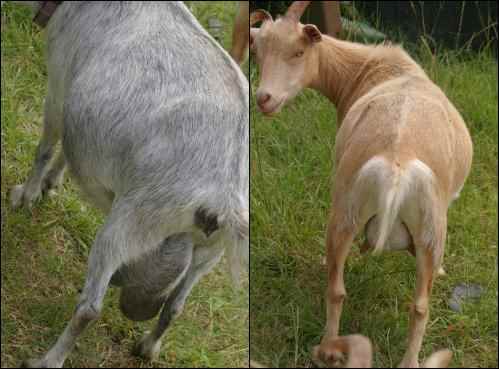
You want a goat with great udders. What does that mean? Firm, strong, balanced udders with good teat development will make for a great milk-goat. In the picture, you can see that the tan goat’s got it goin’ on, and she knows it. The gray goat is a great mother and a wonderful goat, but she has bad udder development. Her udders almost drag on the ground; they have actually been cut and scraped when she climbs over things.
Why do we have a goat with bad udders? The gray goat was our first purchase. We didn’t know what to look for and she was cheap: she cost $75 instead of the normal $200+ for a goat with better udders. A goat with great udders will make baby goats with great udders. When you sell females, good udders mean good profits. When you milk a goat, good udders mean easier milking.
Goats are social animals; never try to keep just one goat. You will need to buy at least two goats, otherwise the solo goat may not eat and will make constant noise. We made the mistake of only getting one goat to start. She would only eat if I was standing out in the field with her. Otherwise she would stand at the fence and cry.
Along with udder development you want to find a goat with a good build, well filled out, clear eyes, healthy appearance, and “clean” pelleted poop. Don’t buy a goat who has diarrhea, isn’t energetic, or otherwise makes you uncertain. A bad goat will take just as much feed and space as a good goat. A goat that consistently has triplets can make a thousand dollars more in profits (over her lifetime) than a goat that only has twins. In other words, paying an extra $100 up front is better than spending lots of food, medicine, and time on a goat that under-performs in the long run.
Milking a Goat
It may seem obvious, but not everyone knows that in order to milk a goat she first must have recently had a baby. Making babies is what makes milk. If you buy a goat for milking, she should be pregnant, recently have given birth, or you will need a buck to impregnate her for future milk-production. Generally, you will let the kids nurse until weaning at about eight weeks, then you will start milking after that. It is possible to keep a goat in milk for months. Then she will need to be “freshened” by getting pregnant again and having babies.
If you want milk year-round you will need at least two females on rotating birthing cycles. It is also possible to hand-rear the kids on artificial formula and milk the doe from the time she gives birth. Just let the kids nurse for the first few days in order to get antibodies from their mother. We leave the kids with their doe until weaning time, but we aren’t aiming for maximum productivity.
Building a Head Hold for Your Milk Goats
Even the most friendly goat isn’t all that interested in standing still for twenty minutes while you milk her. You will need a head hold, or a milking station. You don’t need to buy one. They are easy to make and fairly self-explanatory. My first milking station was made from a wooden pallet and a 2×4. That’s it! Later I built an entire goat “tractor” with a milking station and a yard to hold the goats about to be milked.
A milking stand really just needs two pieces of wood with notches cut out to go around the goat’s neck and hold her head in place. It helps if you include a feed bucket where the goat can eat a little while you are milking her. The head hold in the picture is made with two pieces of wood, a screw at the bottom of one piece that allows it to pivot, and a screen door latch on top to hold it shut.
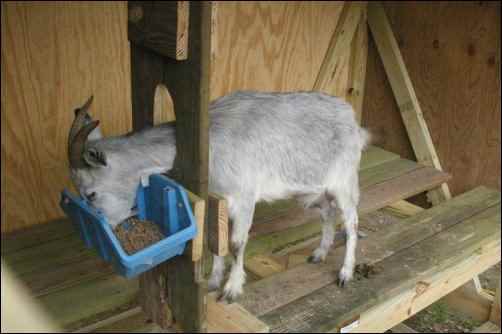
Milking a goat is simply a matter of pinching the teat up near the udder—to trap the milk in the teat—and then squeezing down (like squeezing toothpaste from a tube) to get the milk out. Repeat those steps over and over again until the udder is empty. Occasionally, I will massage the udder to get more milk to drop. Repeat the same steps with each side. You can even go back to side one after milking side two to get a little more milk.
Generally you will want to milk your goats twice each day. Milking more often creates more milk production. You will get more milk overall by milking twice each day than you would by only milking once each day. For us, the process of milking takes about 20 minutes per session per goat, or 40 minutes per day per goat. We aren’t in a big hurry. They do make milking machines for goats, but they are expensive.
My wife wears latex gloves when milking in order to keep her hands from smelling like goat. The exact process for milking is as follows:
1. Put goat in milking station (with some feed).
2. Sanitize the teats and bottom of udders with warm soapy water or a sanitizer diluted in water (like StarSan). Some people also shave or trim the udders to keep hair from getting into the milk.
3. Use a clean jar and milk each side of the goat. Be careful to not let the goat kick over, or put her dirty foot in, the milk receptacle.
4. Cover the jars to bring into the house then STRAIN out any hair or other debris. A quart mason jar is better than a metal bucket for milking goats, in my opinion.
5. Refrigerate, and drink or use to make other products like cheese or soap.

A Word About Goat Milk
Goat milk has smaller fat particles, so it’s harder to separate into cream and milk. The fat stays in the milk, making the milk taste richer than cow milk. Contrary to popular belief, goat milk has the same affect on people with lactose intolerance as cow’s milk. However, many people (like myself), who thought they had lactose intolerance, actually have a milk allergy. If you have a milk allergy (like I do), then goat milk will not cause gastric distress. I’m a big fan of goat milk because it doesn’t affect me like cow milk does.
You can make cheese out of goat milk. We have made both mozzarella and feta type cheese from our goat milk. You can also make soaps and lotions from goat milk. I have never done it myself, however.
What does goat milk taste like? The first time you drink it it will taste “funny” because your brain is telling you that it’s “farmy.” That quickly passes and it tastes just like cow milk, only creamier because the fat is still in it. It can have a slight “earthy” smell depending on how well you clean the teats. It helps to remember that cow milk from the store is separated, processed, and pasteurized before packaging. So consider the difference between goat milk and cow milk to be the same as the difference between fresh-picked green beans from the garden and a can of green beans. Fresh smells better even though it is “farmy.”
Making Goat Babies
A great way to have fun while making profit is to make new baby goats. It’s a trip!! Baby goats are just like any other type of baby, they are fun to watch! In order to make babies you will need a buck. Having a buck in your herd is just like having a man anywhere else… it’s a bit more trouble but you need one to get certain chores done!
Picking a buck is the same as picking does. Look for healthy, clear eyes, good structure and plenty of junk in his trunk. In this case his junk is his scrotum. Don’t worry, it’s easy to spot. It hangs down farther than a does’ udders.
If you want to make “registered” babies then you need a registered buck and registered does. If you just want to make great goats of the same breed then make sure you get goats that look like good examples of the breed. I recommend against getting any sort of cross-bred goats. I’LL SAY THIS AGAIN IN ALL CAPS: DON’T GET CROSS-BRED GOATS FOR BREEDING. They exist, and people may claim that they are just as good or even better. No, they aren’t. And even if they might be, there’s no way to know that what you’re getting is better. Trust the system and keep your herd pure to the breed.
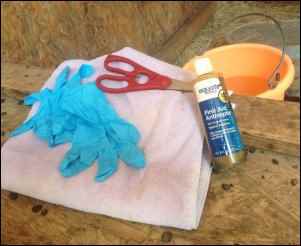
IMPORTANT: If you are going to have baby goats, then it’s very useful to make your goats very FRIENDLY and TRUSTING of humans. Feed them by hand often. Make sure they trust and like you. Because when they start having kids, and you want/need to help the birth, they have to trust you. Otherwise, they will try to run away. Running with a kid hanging out of the back of a doe is not good for either party.
It is possible to just let the doe have her kids “au naturale” without any assistance. But it generally results in more dead kids and possibly even a dead doe. Having assistance can mean the difference between one live kid and three live kids. Since a goat is worth about $200, that’s a $400 profit just from helping out with the birthing process.
To help with birthing you will need a “kit.” The kit should include: iodine, latex gloves, towels, floss, and scissors. The scissors are used to cut the umbilical cord, if necessary (it has never been necessary for me). The iodine is there to treat the umbilical wound on the kid and keep it from getting infected. The gloves and towels are there for obvious reasons. The floss is there to assist in birthing in complicated births.
You will need to research how to deal with goat birthing issues. This article is not designed to do so. Suffice it to say, a kid should come out with it’s front feet and face emerging AT THE SAME TIME. The proper goat birth posture is with it’s face resting on it’s front feet. Anything other than that requires intervention to re-position the kid. One of the most common problems is Rear-First positioning; you will need to turn the kid around. Another problem is Face First But No Feet; that means that the front legs are folded backwards and assistance will be needed to keep the kid from getting stuck in the birth canal (generally a gentle tug).
Do not try to pull on the after-birth or do anything more than is absolutely necessary to help the birthing process. Clean the kid’s nose and mouth to make sure it is breathing, but otherwise leave it alone. The doe will lick it clean. If the kid can’t find the teat in a reasonable amount of time, then help it. What does this look like? It looks like a kid trying to nurse on the barn wall or getting stuck in a corner unsure where to go.
You will be amazed at how fast these goats get moving around. They will be following mom around within hours of birth, and by day two they will seem like they’ve aged a month. The kids in the picture were just born minutes before. The white one was born first, which is why it’s cleaner.
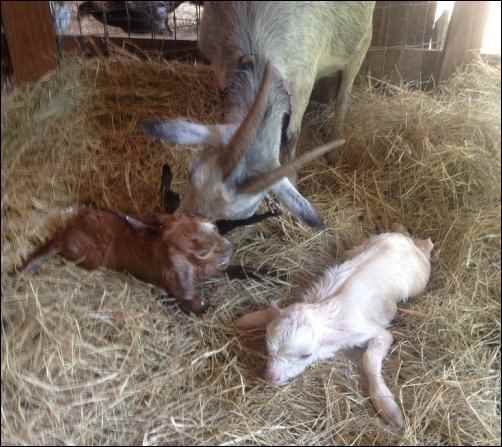
Raising Goats for Fun and Profit
Like I said at the beginning of the article. Goats can be eaten, milked, or sold (to be eaten or milked). Goat milk can be sold (depending on local, state, and national laws) or can be made into products. The difference between making goat cheese and goat milk soap is the FDA. There are lots of rules about making and selling cheese or milk products, but no real rules about selling soap.
We sell male kids at the time of weaning. Even though we sell “dwarf” goats there is a market of people who will raise them to eat. Generally, we will take the males to the local “sale barn” where they are auctioned off. That’s where most males are destined to end up.
We sell females when they are ready to be bred, or we sell them as bred does. It isn’t hard to find buyers. Craigslist.org will do the trick. The lower the price the faster they sell. But, since goats mostly just eat grass/vines/etc., it’s not a great cost to keep the does around until we get the price we want. Worst-case scenario is that they stay long enough to make even more babies! It’s a win-win scenario. However, we have ten acres of pasture. If you are doing this on dirt, or rocks, or in your backyard, time means feed. You can do the math.
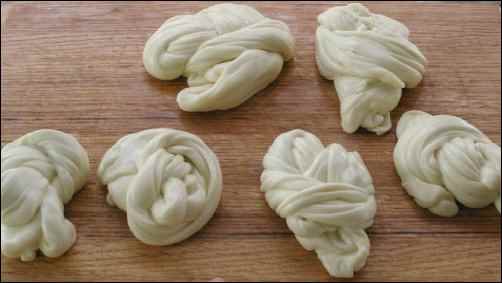
What about soap or lotions? If you have a market, they are very profitable. One could go to people who have booths at local antique-shops and see if they have a shelf to rent, or would engage in some sort of profit-sharing arrangement. Generally, you won’t have enough product to justify a booth of your own, but if you can sublet a shelf, then it will be a profitable undertaking.
The idea of selling these things at the flea market may seem like a good idea, but flea markets cost money and will eat up your entire weekend. So it’s better to find a passive way to sell your products. Online places like Etsy may work as well. But remember what you are selling isn’t a product. You are selling a STORY. “This lotion was hand-made in God’s country on a sepia-toned farm using traditional methods on a red-checker-covered farm table while a rooster crowed in the background and happy goats grazed on the hillside. Won’t your hands feel softer because of it? Of course they will!”
No matter how you do it, no homestead is complete without a couple of goats, even if they are just for taking cute photos.
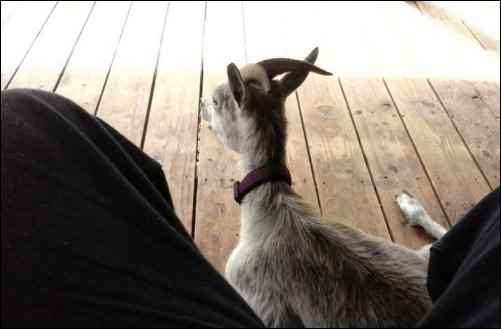











Thanks for this article. It was well-written, informative, and enjoyable!
If I just buy 2 nigerian dwarf does is it usually easy to find someone to breed with their buck and does it cost much? Also how many pregnancies can a doe have?
Sorry for the long delay. The answer to your first question is.. it depends on where you live. Find local facebook page to join. If you’re in the country you may notice some as you drive. If you look on Craigslist and find someone selling Nigerians you might call them and ask. Cost is relative. I never paid to breed mine. If I did and I had 2 does I would try to shoot for $50-$75 if they brought their buck over and let it hang out with the does for a week or two. But, that’s just me.
I would say the number of pregnancies are just a function of the doe and how her body holds up. If she’s carrying them and her utters aren’t completely shot then all is good (for me) . others might have a different opinion. I once had a doe who had one really low udder that would scrape on things when she walked over them. This can lead to cuts and infections. I sold her when it became a problem. Any other feedback on this would just be me looking things up on the internet, not personal experience.
Hello! What a wonderfully informative article. Thank you for posting it.
I understand these goats can live up to 15 years, but I am curious about how long they can breed and subsequently be milked for until they dry up permanently. I.e. How many years of their life are the goats milkable?
That’s a good question. I don’t have personal experience to answer it, since mine are all young. Any answer I give would just be a guess based on an internet search. I prefer to just share stuff that I have first hand experience with.
I have read to keep the males separate when females are producing milk to preserve the taste of the milk. How far (distance) apart should they be separated?